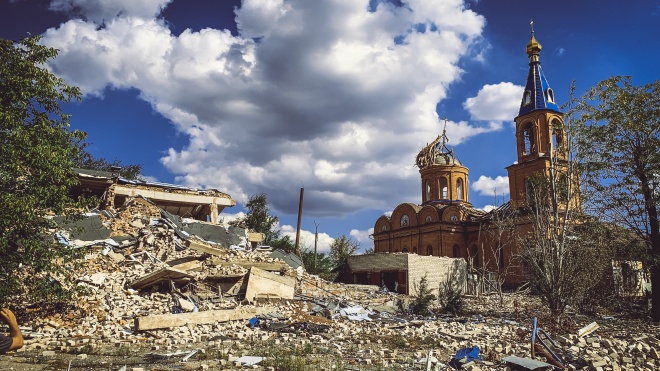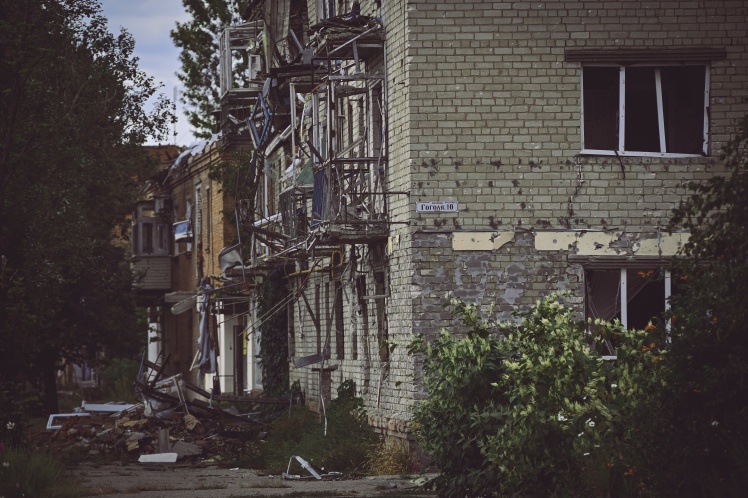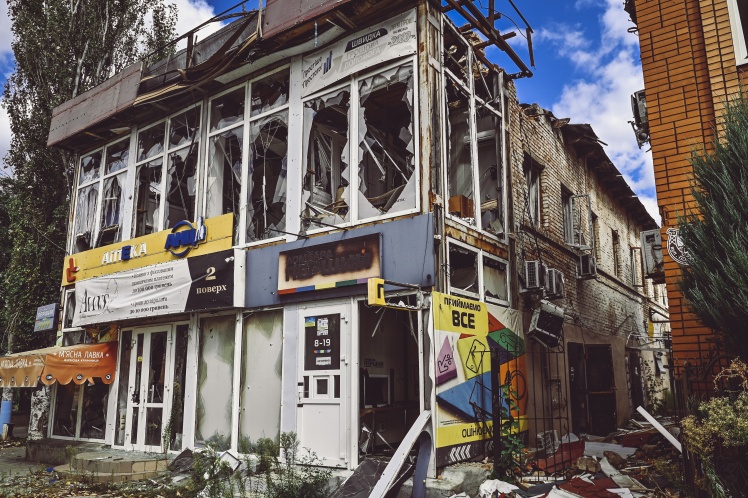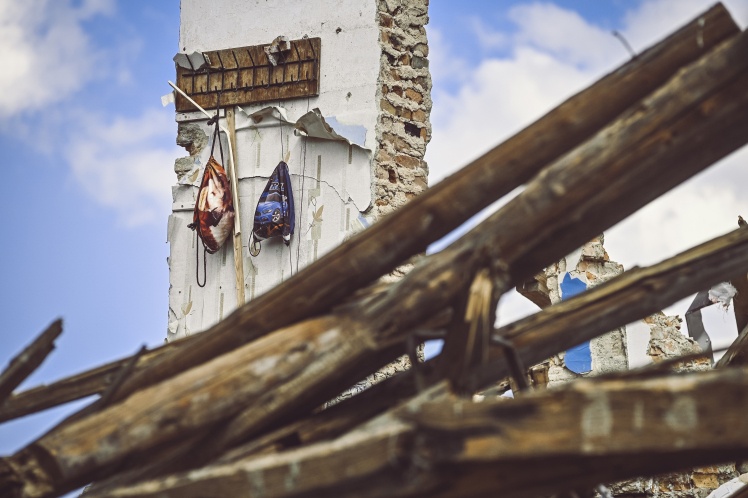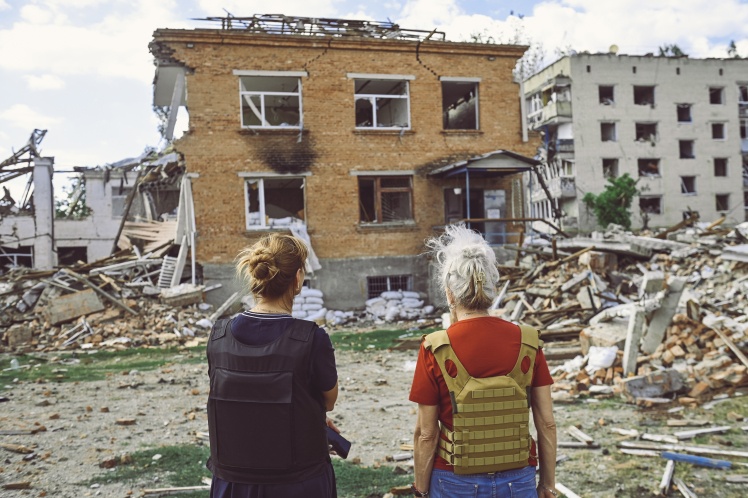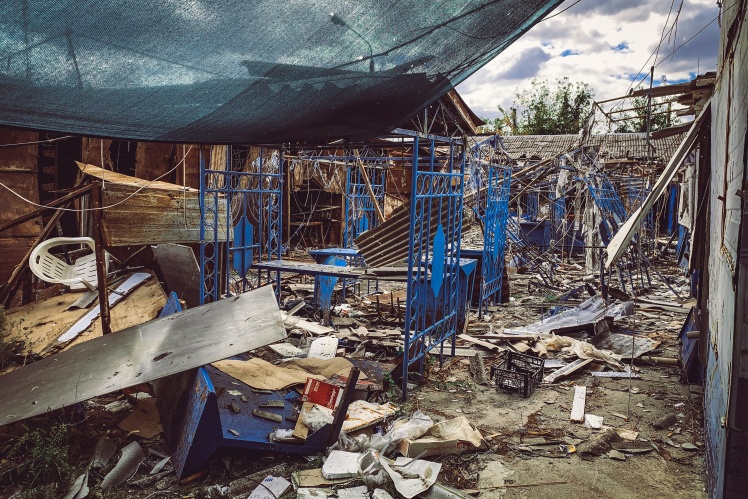Orikhiv was founded three hundred years ago by Cossacks and peasants from central Ukraine. There is a version that earlier this area was overgrown with hazels, groundnuts and water nuts, which is why the name Orikhiv arose. But most likely, this name was given to the settlement by settlers from the village of Orikhiv in the Poltava region, who moved here in the 18th century.
There are no three-hundred-year-old buildings left in Orikhiv, but there are some built in the 19th century. For example, the house of the German Mennonite Heinrich Jantzen, who created the first mill on a steam engine here, opened a school and a hospital. Other historical monuments have also been preserved — century-old shopping rows and the Church of the Intercession. But in a year and a half, the Russians destroyed all this with artillery and aerial bombs.
Shopping rows are a historical monument of the 19th century. Destroyed by aviation in August 2023.
Олексій Ковальов / «Бабель»
The Russians shelled the Pokrovsk Church with artillery in October 2022, and bombed it with aerial bombs in the summer of 2023.
Олексій Ковальов / «Бабель»
By February 2022, 14,000 people lived in Orikhiv. Although the town is small, it is the largest on the way to Zaporizhzhia. The Russians tried to occupy it in order to have a bridgehead for capturing the regional center. From Orikhiv to Zaporizhzhia is an hourʼs drive on a direct road.
In the spring of 2022, the fighting took place 3-4 kilometers from Orikhiv. The Armed Forces of Ukraine managed to stop the Russian army and push it back ten kilometers from the city. But this distance did not protect the inhabitants from artillery shells and rocket systems of salvo fire.
All the buildings in Orichov were shot at and burned.
Олексій Ковальов / «Бабель»
In the spring of 2023, the Russians began dropping guided aerial bombs on the city. The Orikhiv State Emergency Service explained to Babel that these were modified unguided high-explosive bombs. Wings and engine, control modules are attached to high-explosive bombs. A Russian plane rises into the sky at a distance of 40-50 kilometers in the occupied territory of the Zaporizhzhia region and launches bombs. These bombs with charges of 250 kg, 500 kg and 1.5 tons of dynamite fall on Orikhiv.
Ukraine cannot eliminate the factor of these bombs now. Itʼs possible to shoot them down by S300 and Buk air defense systems. According to Yuriy Ignat, the spokesman of the Air Force of the Ukrainian Armed Forces, the S300 can shoot down targets at a range of up to 75 km, and the Buk-M1 — up to 35 km. But so close to the front line, the Russians will immediately destroy them. F-16 planes, which Ukraine does not yet have, can be a reliable defense against anti-aircraft missiles. As well as the PATRIOT and SAMP-T air defense systems, which can shoot down these missiles while being far from the front. But these installations are not enough to protect the entire country.
A tear from an aerial bomb in the middle of the street. The explosion destroyed all the private houses nearby.
Олексій Ковальов / «Бабель»
Funnel from an aircraft bomb with a charge of 500 kg of TNT. She fell on a playground between high-rise buildings. The hole is 12 meters in diameter and 7 meters deep.
Олексій Ковальов / «Бабель»
Explosions from bombs in Orikhiv yards are a common picture. The bomb that left the hole in the photo above fell into the ground, so the high-rise buildings nearby did not collapse. 88-year-old Lyudmila Afanasiivna lives in one of them. She was hiding in the entrance during that shelling. He remembers how the house shook from the blast wave. The woman lived in Orikhiv throughout the war, but is now going to visit her son in Zaporizhzhia.
The Russians can launch from three to five bombs at the same building. School No. 3 was bombed by three aerial bombs in July 2023. There was an indomitable point at the school. Fifteen people were in his shelter during the bombing, seven died.
All that remains of the old school, where the "Point of Invincivility" has been operating since 2022. People warmed up there, cooked food and could stay together. The Russians dropped three aerial bombs on the "Point of Invincibility". Bags with clothes are still hanging on one of the school walls.
Олексій Ковальов / «Бабель»
Local volunteer Lyubov Yarova was at school during that airstrike. She tells Babel that the bombs fell one after another. She does not understand how anyone survived in the basement.
“When I came to my senses after the bombing, I didnʼt see anything — everything was in dust. I touched a person with my hand, and itʼs alive. Then I crawled to the other one — that person was dead,” — remembers Yarova. She walks everywhere with her dog Victory. And calls her the wife of the sapper dog Patron — they are of the same breed and look very similar.
Lyubov Yarova, after surviving at school, evacuated from the town. But sometimes she returns to Orikhiv to show journalists the consequences of shelling.
Олексій Ковальов / «Бабель»
The school building was more than a hundred years old. Oleksandr studied there half a century ago. His dilapidated house is on the same street as the school. Oleksandr remembers how as a child he used to climb the roof of the school, playing with his peers. He says that now he often thinks about his childhood, hiding in the memories of the war.
Oleksandr lives on his own, his son and daughter-in-law are now in Zaporizhzhia. During one of the shellings, they were wounded, so they went for treatment to the regional center and stayed there. They call their father to come, but he does not want to — he is going to live in Orikhiv for the second winter in a row. He says that his house is only half destroyed, so it will survive the frost. Now the man is preparing for the cold — he collects firewood. He walks through the ruins and looks for pieces of furniture, says that he found a lot of wood just in the ruins of the school.
Oleksandr never left Orikhiv. He remembers that before the war, people were constantly walking down his street, and now he has no one to talk to for the whole day.
Олексій Ковальов / «Бабель»
When anti-aircraft missiles and shells fly into the city, Oleksandr hides in his cellar, which is surprisingly still intact. There are no basements in the city that can withstand aerial bombardment, so the man resigned himself to the fact that he might die. Only he and two neighbors live on his street now — three lonely pensioners.
Local police told Babel that families with children were evacuated from the town in the spring of 2023. Law enforcement officers, emergency services and doctors continue to work, putting out fires and getting people out from under the rubble. They do not even plan to dismantle the destroyed houses. In general, no one here thinks that itʼs possible to restore Orikhiv — the town has been destroyed.
The man put together the books he found in the ruins of the school. He will make a fire and cook food with them.
Олексій Ковальов / «Бабель»
There is no electricity, water or gas in Orikhiv, shops and pharmacies are closed. Trade remained only on the market, which was also largely destroyed. But there is a surviving corner where four saleswomen work. On the trays, the goods that are currently in the greatest demand in the city are washing powder, sweet water, candies and bread. Cereals, canned goods and everything else are brought as humanitarian aid.
The women bring the goods from Zaporizhzhia. Each of them has their own reasons for staying: they donʼt want to abandon the animals, they have bedridden relatives, and some simply have no one to go to. Saleswomen are allowed to take pictures of their counters, but they do not want to be in the frame themselves — they are afraid of shelling.
All that is left of the local market.
Ganna Mamonova / "Babel"
According to the police, on an average day, the Russians drop from four to ten aerial bombs in addition to up to 20 artillery missiles. On one of the days there were 28 bombs. When asked how people can stand it, the police say: "Itʼs impossible to stand it. Itʼs terrible".
The buildings on Myru (Peace) Street were completely destroyed.
Олексій Ковальов / «Бабель»
Translated from Ukrainian by Anton Semyzhenko.
Babel will continue to travel to the front line to tell about peopleʼs lives. Your help will make it easier for us. Support us: 🔸 in hryvnia , 🔸 in cryptocurrency , 🔸 Patreon , 🔸 PayPal: [email protected] .
